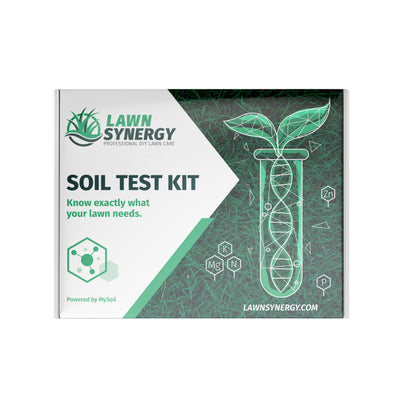A soil test for your lawn revels many key indicators if your looking to grow a nice looking healthy lawn. 9 times out of 10, even a lawn expert can't accurately diagnose a lawn by just looking at it. If your lawn is in rough shape or you are trying to take your lawn to the next level, read on.
Soil tests for lawn care show us the main key components that would need to be corrected right away, and also secondary issues that should be corrected to help make your lawn healthy and strong.
Primary Indicators:
- PH
- CEC's (cation exchange capacity)
- Phosphorus
- Potassium
- Organic content
- Bulk Density
We always look at the ph level of our soils to start. Soil ph will show us how acidic or alkaline our soil is when growing grass. If its too low, acidic soils will hurt root development and lawns will likely have shallow roots. If it is too high, alkaline soils can stunt growth, cause yellowing, and decrease nutrient utilization.
Soil ph for a lawn is just as critical as ph of a swimming pool. If the ph is too high or too low, the chlorine does not work as well and the water becomes cloudy. Same goes for your lawn. Too high or too low, the grass will not look as good, will not be as healthy, and will not be deep green.
How to correct high or low ph in your lawn?
Ideal ph for your lawn is between 6-7. If the ph is too low, you can increase ph by applying lime. We recommend applying our Phast-cal product because it contains calicitc lime which works much faster than conventional lime and it also contains kelp which increases root growth and nutrient efficiency.
If your ph is too high, we recommend applying sulfur to decrease ph. After you have applied corrections to your lawn, wait about four months to retest ph. Another application may be needed to find the sweet spot your lawn is looking for.
What are CEC's and what does it tell?
The cec level of your soil shows what the nutrient exchange capacity is and how mulch the soil can release to your lawn. The higher the number the better. We suggest bringing the cec level of your soil up to the teens. Often we see poor lawns that are in rough shape have low cec levels of 4-9.
To increase cec level:
- Make sure your ph is in the ideal range of 6-7
- Increase organic content
- Mulching your lawn with a mulching mower each week instead of bagging.
- Lawn Synergy Organic + applied at 15 lbs./1000 sq. ft.
- Lesco CarbonPro-G applied at 10 lbs./1000 sq. ft.
Phosphorus and Potassium Nutrients
Phosphorus (P) is what grows deep roots. It is a key nutrient for your lawn. Too much phosphorus can lock up other nutrients not making them available to the lawn. If P is too low, apply the recommended amount needed required by the soil test results.
Potassium (K) is one of our favorites when it comes to lawn care. Potassium provides your lawn with strength, by increasing the turgor pressure of the cells within the lawn making it stronger. By having a stronger lawn, we prevent diseases, stress from drought and heat, and also frost damage.
Always make sure enough potassium is available when growing a healthy lawn. A soil test will provide recommendations on how much potassium is required to bring it up to normal levels.
How do I Increase Organic Content in Soil?
The higher the organic content the better in soils. Organic content provides increased water retention, lawn stress resistance, increased nutrient efficiency, and higher cec levels.
Start by always mulching in grass clippings when mowing. Mulching will recycle nutrients, increase organic content, and increase the health of your lawn. Make sure any clumps are removed because they will do more harm than good.
Lawn Synergy's Organic+ product will also add organics to the soil and feed those microbes. Milorganite is another similar product that will do the same.
We recommend adding a load of organics when opening up your soils at time of core aeration. Aeration will allow the granules to get down into the soil greatly improving organic content.
Correcting Bulk Density of Soil
Having a high bulk density in the soil typically higher than 1.0 will indicate that the soil is able to compact very easily. Soil that is compacted can damage your lawn. Foot traffic, heavy rains, and mowing will compact the soil over time.
What soil compaction does to your lawn:
- Nutrients are unable to reach roots of the lawn
- Fertilizer often sits on top of the soil causing algae to develop
- Water is unable to penetrate soil causing dry roots and drought damage
Apply gypsum. Gypsum will prevent the soil from sticking together which then becomes compacted. Also increasing organic matter will also help raise bulk density.
Apply gypsum at a rate of 50 lbs. per 1000 sq. ft. Yes that is a lot of gypsum but its required if you have a high bulk density. Applying gypsum can be done at any time of the year but it is best to be applied at time of aeration so the granules can get down into the soil.
Once you have ph, key nutrients, cec's, organic content, and bulk density all under control, you will see a big difference in how your lawn reacts. When applying an application of fertilizer, you should notice a big bang in the results. The lawn should be much stronger, greener, and even healthier.
Monitor the soil at least once per year by using a soil test from Lawn Synergy. We take soil tests seriously and it helps us reveal the actual issues that need to be corrected right away.


